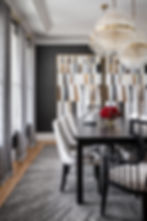The Art of Mixing Textures in Interior Design
- DuVäl Reynolds
- Jul 27
- 4 min read
Updated: Aug 10
When it comes to creating a stylish and captivating interior, mixing textures is a powerful design tool. By combining different materials, finishes, and fabrics, you can add depth, warmth, and personality to your spaces. This is especially relevant for homeowners on the East Coast, where diverse architectural styles and fast-paced lifestyles demand both functionality and aesthetic appeal. Whether you're aiming for a luxury feel, a contemporary vibe, or something uniquely personalized, mastering the art of texture can transform your home.
Here’s everything you need to know about incorporating mixed textures into your interior design, along with tips fit for this lifestyle.
Why Mixing Textures Matters
Textural layering does more than add visual complexity — it creates balance and invites the senses to engage with your space. Think of a room with smooth walls, glossy finishes, and sleek furniture. While cohesive, such a design might lack a welcoming touch. Introduce soft textiles like a plush rug or a knitted throw, and suddenly, the room feels alive and inviting.
For homeowners striving to fuse luxury with comfort, as is often demanded on the East Coast, layering textures bridges the gap between elegance and livability.
Textures in Design
Soft Textures — Fabrics like velvet, wool, and linen provide comfort and warmth.
Hard Textures — Surfaces like marble, glass, and metal exude sophistication and structure.
Natural Textures — Materials such as wood, leather, and rattan connect interiors to nature and add an organic flair.
By thoughtfully combining these elements, you can craft spaces that are both beautiful and functional.

How to Mix Textures in Your Home
Mastering texture mixing involves creativity and restraint. Here are steps and actionable tips to get started.
Layer Fabrics for Depth
Fabrics are a quick and versatile way to incorporate texture into your design. Mix and match textiles to add layers of depth to any room. For example:
Pair a smooth leather sofa with soft silk pillows and a chunky knit throw.
Use velvet curtains to complement light, airy linen sofas.
This approach works particularly well where climate fluctuations call for cozy interiors in the winter and cooler fabrics in the warmer months.
Balance Smooth and Rough Surfaces
Contrast is key to creating visual interest. Pairing smooth materials like glass or polished stone with rougher finishes, such as distressed wood or woven rugs, enhances the overall feel of the room.
Example Application: Imagine a dining room table made of reclaimed wood paired with sleek, metal-frame chairs. This combination delivers a sophisticated mix of rustic charm and modern minimalism, perfect for urban homes with tight spaces.
Use Rugs to Tie Everything Together
Rugs are an underrated texture element that can anchor a space. Choose patterns or materials that align with your design goals:
A bold geometric rug for rooms aiming for a modern edge.
A soft, neutral wool rug for understated elegance and comfort.
Rugs also act as ideal insulators, especially during colder months, an added advantage in regions that experience all four seasons.

Introduce Natural Elements
Nature-inspired textures create an elegant yet approachable aesthetic. Infuse your space with organic elements like jute, seagrass, or cane. These aren’t just visually appealing—they evoke calmness and serenity.
Practical Tip: Use rattan furniture or woven baskets for storage to complement hardwood floors typically found in DC homes while maintaining a modern yet timeless look.
Add Metal Accents for a Touch of Luxury
Metals like brass, polished chrome, or matte black finishes enhance your interiors with a sophisticated edge. Use them sparingly in fixtures such as lamps, picture frames, or cabinet handles to avoid overwhelming the room.
This subtle touch aligns beautifully with the upscale aesthetic often sought in luxury homes.

Local Considerations for the DC Metro Region
Homes in the DC metro area often feature classic architecture, ranging from Federal-style rowhouses to modern high-rise apartments. While these architectural features set a strong baseline for design, incorporating varied textures can make even an older space feel contemporary.
Climate: With hot, humid summers and chilly winters, use texture to adjust the feel of your home seasonally. Opt for lightweight linen and cotton in warm weather, transitioning to wool throws and velvet accents as temperatures drop.
Lifestyle: The fast-paced urban environment demands low-maintenance yet elegant solutions. Textured finishes, such as wood or metal, are not only visually appealing but also durable—perfect for homes that need to combine style with practicality.
Common Mistakes to Avoid
Mixing textures can elevate your home, but overdoing it can clutter your design. Here’s what to watch out for:
Too Many Competing Elements: Balance is key. Avoid juxtaposing more than three textures in one space.
Neglecting Cohesion: Make sure the textures complement your color palette and overall style.
Ignoring Practicality: Consider the daily use of your space—fragile or high-maintenance textures might not work for high-traffic areas.
Your Next Steps
For homeowners looking to transform their living spaces, experimenting with textures is one of the most effective ways to create depth, warmth, and elegance. If you're unsure where to start, consider partnering with local interior design experts who can tailor designs to your specific space.
Contact DuVäl Design Today: At DuVäl Design, we specialize in curating interiors that reflect your personality while incorporating modern interior design trends. Whether you're blending textures in your living room or updating a single bedroom, our team provides personalized services tailored to the distinctive needs of the DC metro region. Reach out today to start your design transformation!
See our portfolio: https://www.duvalreynolds.com/work
Follow us on Instagram: @duvaldesignllc
